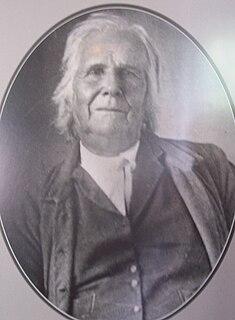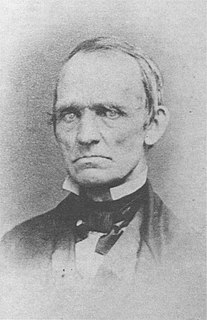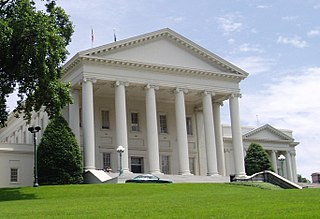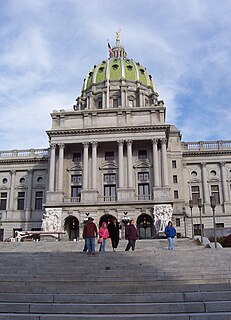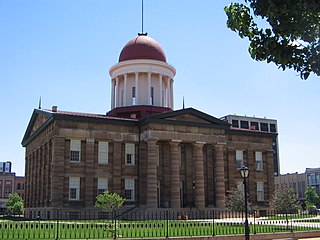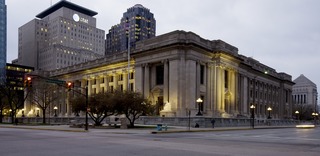Indiana State House | |
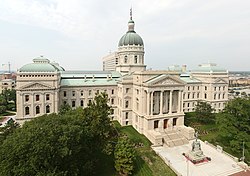 Indiana Statehouse in Indianapolis | |
| Location | W. Washington St., Indianapolis, Indiana |
|---|---|
| Coordinates | 39°46′7.54″N86°9′45.54″W / 39.7687611°N 86.1626500°W Coordinates: 39°46′7.54″N86°9′45.54″W / 39.7687611°N 86.1626500°W |
| Built | 1878-1888 |
| Architect | May, Edwin; Scherer, Adolf |
| NRHP reference # | 75000043 [1] |
| Added to NRHP | August 28, 1975 |
The Indiana State House is the state capitol building of the U.S. state of Indiana. Housing the Indiana General Assembly, the office of the Governor of Indiana, the Supreme Court of Indiana, and other state officials, it is located in the state capital Indianapolis at 200 West Washington Street. Built in 1888, it is the fifth building to house the state government.

In the United States, a state is a constituent political entity, of which there are currently 50. Bound together in a political union, each state holds governmental jurisdiction over a separate and defined geographic territory and shares its sovereignty with the federal government. Due to this shared sovereignty, Americans are citizens both of the federal republic and of the state in which they reside. State citizenship and residency are flexible, and no government approval is required to move between states, except for persons restricted by certain types of court orders. Four states use the term commonwealth rather than state in their full official names.

Indiana is a U.S. state located in the Midwestern and Great Lakes regions of North America. Indiana is the 38th largest by area and the 17th most populous of the 50 United States. Its capital and largest city is Indianapolis. Indiana was admitted to the United States as the 19th U.S. state on December 11, 1816. Indiana borders Lake Michigan to the northwest, Michigan to the north, Ohio to the east, Kentucky to the south and southeast, and Illinois to the west.

The Indiana General Assembly is the state legislature, or legislative branch, of the state of Indiana. It is a bicameral legislature that consists of a lower house, the Indiana House of Representatives, and an upper house, the Indiana Senate. The General Assembly meets annually at the Indiana Statehouse in Indianapolis.
Contents
- History
- First statehouse
- Second statehouse
- Third statehouse
- Fourth statehouse
- Current Statehouse
- Construction
- Renovation
- Public artworks
- Gallery
- See also
- Notes
- References
- External links
The first statehouse, located in Corydon, Indiana, is still standing and is maintained as a state historic site. The second building was the old Marion County courthouse which was demolished and replaced in the early 20th century. The third building was a structure modeled on the Parthenon, but was condemned in 1877 because of structural defects and razed so the current statehouse could be built on its location.

The Corydon Historic District is a national historic district located in Corydon, Indiana, United States. The town of Corydon is also known as Indiana's First State Capital and as Historic Corydon. The district was added to the National Register of Historic Places in 1973, but the listing was amended in 1988 to expand the district's geographical boundaries and include additional sites. The district includes numerous historical structures, most notably the Old Capitol, the Old Treasury Building, Governor Hendricks' Headquarters, the Constitution Elm Memorial, the Posey House, the Kintner-McGrain House, and The Kintner House Inn, as well as other residential and commercial sites.

Corydon is a town in Harrison Township, Harrison County, Indiana. Located north of the Ohio River in the extreme southern part of the U.S. state of Indiana, it is the seat of government for Harrison County. Corydon was founded in 1808 and served as the capital of the Indiana Territory from 1813 to 1816. It was the site of Indiana's first constitutional convention, which was held June 10–29, 1816. Forty-three convened to consider statehood for Indiana and drafted its first state constitution. Under Article XI, Section 11, of the Indiana 1816 constitution, Corydon was designated as the capital of the state until 1825, when the seat of state government was moved to Indianapolis. During the American Civil War, Corydon was the site of the Battle of Corydon, the only official pitched battle waged in Indiana during the war. More recently, the town's numerous historic sites have helped it become a tourist destination. A portion of its downtown area is listed in the National Register of Historic Places as the Corydon Historic District. As of the 2010 census, Corydon had a population of 3,122.

The Parthenon is a former temple on the Athenian Acropolis, Greece, dedicated to the goddess Athena, whom the people of Athens considered their patron. Construction began in 447 BC when the Athenian Empire was at the peak of its power. It was completed in 438 BC, although decoration of the building continued until 432 BC. It is the most important surviving building of Classical Greece, generally considered the zenith of the Doric order. Its decorative sculptures are considered some of the high points of Greek art. The Parthenon is regarded as an enduring symbol of Ancient Greece, Athenian democracy and Western civilization, and one of the world's greatest cultural monuments. To the Athenians who built it, the Parthenon and other Periclean monuments of the Acropolis were seen fundamentally as a celebration of Hellenic victory over the Persian invaders and as a thanksgiving to the gods for that victory. As of 2007 the Greek Ministry of Culture was carrying out a programme of selective restoration and reconstruction to ensure the stability of the partially ruined structure.






